Proper installation and ducting are crucial for the unit system to achieve excellent performance, energy efficiency, and longevity of the whole-house dehumidifier unit. This article is written for both homeowners and professionals, as it details the steps in integrating a dehumidifier into your HVAC system. Choosing the right location and understanding the design of the ducts, making the necessary electrical connections, and other practices are illustrated in this guide. The systematic instructions provide the knowledge needed to improve indoor air quality, control excessive indoor humidity, and effectively achieve comfortable conditions in a construction environment.
What are the benefits of installing a whole-house dehumidifier in your ductwork?
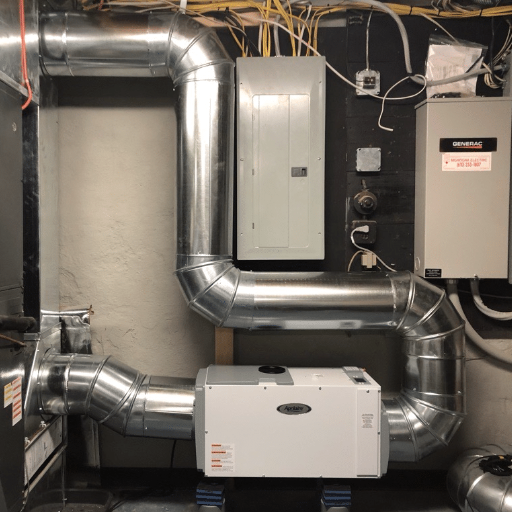
The advantages of installing a whole-house dehumidifier can be significantly enhanced if installed in the ducted system. First, it helps to eliminate problems of excess humidity, which might lead to mold, dust mites, internal moisture, or any update to water deep in the structures. It integrates with the hvac system and allows for consistent humidity levels in all house areas, averting localized chilling. It also enables energy efficiency since room air conditioners can function efficiently; thus, less money is used on cooling. The installer’s ability to take care of these systems dramatically influences the interior’s air quality by eliminating potential allergens and improving the quality significantly for those who occupy it.
How does a ducted dehumidifier improve indoor air quality?
By ensuring that indoor humidity levels are kept to a certain degree with the help of ducted dehumidifiers, mold, mildew, and dust mites, which are common allergens that thrive in humid areas, can be significantly inhibited. In addition to the above, ducted dehumidifiers eliminate excess moisture within homes, which helps prevent microbial growth on nearly all duct surfaces. Also, many ducted dehumidifiers come with robust filtration systems that can capture airborne dust particles, pollen, and pet dander, which are prevalent sources of allergens. When combined, the moisture, as mentioned above, and particle filtration techniques result in a better indoor environment, which has proved effective for those suffering from respiratory issues or allergies.
Can a whole-house dehumidifier help reduce energy costs?
In addition to the above, a whole-unit dehumidifier can also help reduce energy costs significantly. According to a study, over 50% of energy costs can be saved with the help of a correctly set up dehumidifier with an air conditioning system. Dehumidifiers cut down on the work of air conditioning systems to keep humidity levels within the home to a specific range, and that, in turn, helps the air conditioning units to function better. On rare occasions, when the air inside becomes dry, making one feel warm, the thermostat can be set slightly higher to maintain optimum comfort levels. This lowered dependency on air conditioning units helps reduce energy usage and, as a direct concern, helps bring down the number of utility bills being racked up.
What are the advantages of dehumidification throughout the house?
There are many reasons why one could consider dehumidifying their house. The most pressing reason could be protecting the integrity of the structures from mold and mildew, which ultimately results in better air quality and aids people with breathing complications and allergies. Controlling the level of humidity deters a large number of allergens, such as dust mites and cockroaches. Most importantly, controlled humidity reduces the workload and wear off on HVAC systems, which prolongs their lifespan. The improved living conditions, along with energy efficiency, promote long-term savings as well.
How do you choose the right whole-house dehumidifier for your HVAC system?
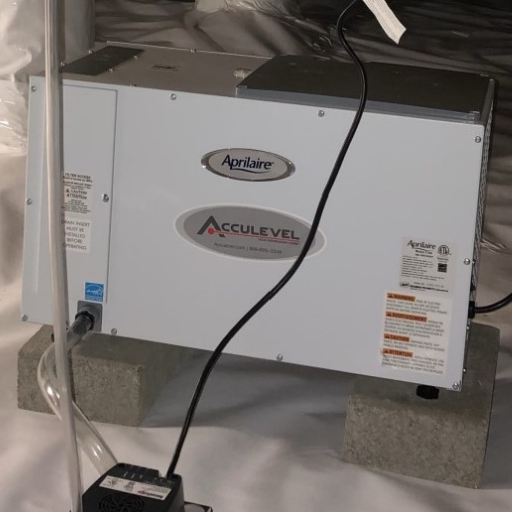
Some factors need to be measured to choose the best whole-house dehumidifier. Firstly, you need to roughly estimate the amount of dehumidification required by measuring the pints needed per day and the humidity in the space in correlation to its square footage. Ensure the existing HVAC system is compatible and meets the airflow and ductwork requirements. Dehumidifiers with ENERGY STAR certification are highly recommended as they can lower operational costs without impacting performance due to being more energy efficient. Having units with automated and programmable features can be helpful for accurate humidity control. Last but not least, always check with an HVAC professional to ensure that correct measures have been taken regarding sizing, integration, and aiding to achieve the results that were aimed for.
What factors should you consider when selecting a ducted dehumidifier?
There are many factors to consider when choosing a ducted dehumidifier. The starting point should be assessing the dehumidification capacity that a ducted dehumidifier possesses, as this varies from one model to another. However, it is worth noting that undersizing and oversizing HVAC units can affect their performance and energy consumption. Having an ENERGY STAR rating is paramount as this plays an integral role in ensuring energy costs are kept in check while guaranteeing effective operation. Furthermore, other factors must also be considered, such as the compatibility of any ducted dehumidifier with one’s HVAC system and ductwork. Other factors worth considering include noise levels, filter types, and additional features such as remote monitoring and programmable settings. Seeking the assistance of an HVAC professional is always recommended, as they can provide highly specialized and tailored recommendations that align with your needs.
Are there different types of whole-house dehumidifiers for various duct systems?
Different kinds of whole-house dehumidifiers are compatible with certain types of duct systems. Some models can be installed directly onto the existing central ductwork of your HVAC system, while others function with their ducts. Ducted dehumidifiers can also differ in size, airflow rates, and installation, which enables them to become part of diverse systems. Choosing the right model that fits your ducts is critical for best performance and efficiency. Such information can also be found in the installation instructions or with a professional.
How do you determine the appropriate size and capacity for your dehumidifier?
To use a dehumidifier in a space, you must determine its correct size and capacity. This depends on the area’s square footage, humidity, and temperature. The size and capacity of a dehumidifier are usually measured in PPD or Pints Per Day, which informs the user about the moisture that can be removed from the air. Small spaces, up to 500 square feet with low humidity, usually require 20-30 PPD dehumidifiers. Medium spaces typically lie between 500 and 1500 square feet with moderate moisture, generally requiring 30-50 PPD units. However, large spaces that are 1500 square feet or more can usually need 50-70 PPD or more.
Other factors that can be considered include the specific conditions of the area. Heavy-duty equipment may be more appropriate if a damp basement or crawl space has low airflow. Size recommendations can also be obtained by referring to several manufacturers’ sizing charts. Continually evaluate the claimed capacity against that of your room and factor in the Energy Star rating for effective long-term operation. Use a hygrometer to gauge the moisture level and select a unit appropriate to your needs for accuracy.
What are the steps to install a whole-house dehumidifier in your existing ductwork?
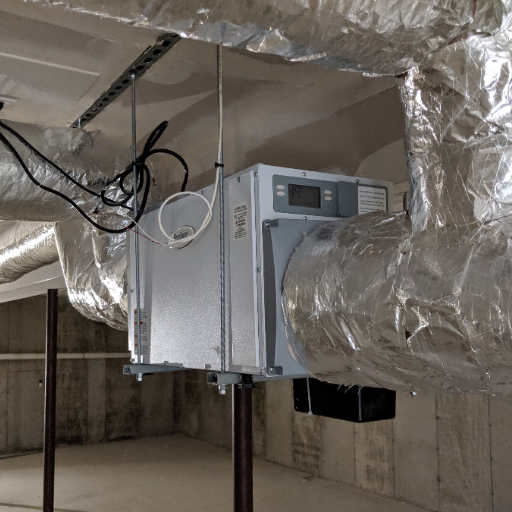
- Assess the System Requirements
Begin by evaluating your HVAC system to ensure compatibility with the dehumidifier. Confirm sufficient space near the ductwork for installation and verify airflow specifications to align with the unit’s capacity.
- Select an Appropriate Location
Identify a location for the dehumidifier near your central return duct. The unit should be easily accessible for maintenance and positioned to minimize excessive bends in the ductwork.
- Connect the Unit to the Ductwork
Cut into the return duct and attach the intake duct of the dehumidifier. Use sheet metal screws and duct tape to ensure airtight seals. Connect the unit’s output to the supply duct if required by the design.
- Install the Drain Line
Set up a drain line to remove condensed water. Direct the line toward a floor drain, sump pump, or external drainage system to ensure proper drainage.
- Wire the Electrical Components
Connect the dehumidifier to a dedicated power source. Follow all manufacturer guidelines and local electrical codes. You may need to integrate the unit with a humidistat or separate control system.
- Test the System
Power on the dehumidifier and check for proper functionality. Verify that airflow is unobstructed, drainage is efficient, and the system responds appropriately to changes in humidity levels.
- Seal and Insulate as Needed
Seal any gaps or leaks in the ductwork and insulate the connections to prevent energy loss and improve efficiency.
Carefully follow the manufacturer’s instructions throughout the installation, and consult a professional HVAC technician if necessary.
How to prepare your HVAC system for dehumidifier installation?
Toilet dehumidifier installation starts by preparing the HVAC system; cleaning and servicing the system is one such practice, as is swapping out air filters and cleaning coils for airflow issues. I check that the ducts are properly connected — this is also very important for such equipment. The air conditioning systems are checked for compatibility with the dehumidifiers and the system capacity, as the devices must operate together. Finally, all local building regulations and manufacturer’s recommendations applicable for the type of equipment being installed are reviewed so that correct installation can be done afterward.
Where is the best location to install a dehumidifier in your duct system?
Air conditioners should preferably be fitted with ducted dehumidifiers installed on the return side of the ducts close to the air handling unit to ensure the incoming air is dehumidified before it enters the system. This ensures that the dehumidifiers work effectively and balanced airflow in the HVAC system is achieved. However, I also consider the configuration of the existing ductwork, the amount of space available, and what the manufacturer suggests to arrive at the most suitable and economical position for installation.
What tools and materials are needed for dehumidifier ducting?
A robust toolset and materials are essential for effective dehumidifier installation and integration with the HVAC system. The tool kit includes a tape measure, crimper, shears, a drill, and a screwdriver. These specific tools assist with extending, trimming, and assembling ducts. Rigid or flexible ductwork, collars, clamps, aluminum foil tape, and insulated duct wrap are required to handle air while avoiding air loss. Observing the manufacturer and related construction regulations ensures a durable and practical installation.
How do you properly connect a dehumidifier to your supply plenum and return duct?
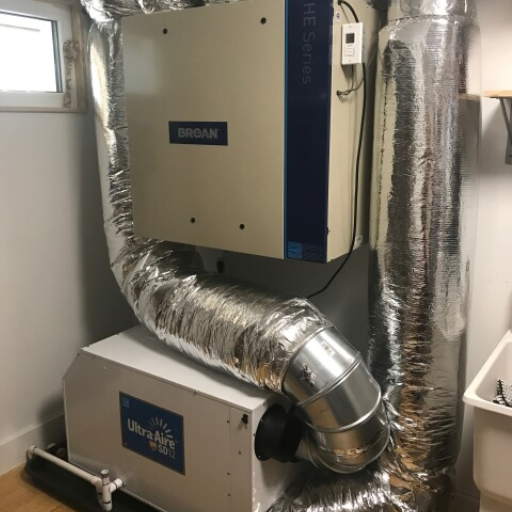
The first step involves selecting an installation site to ease the maintenance process. Ensure proper airflow while measuring, cutting, and making openings on the supply plenum and the return duct with the duct collars of the dehumidifier. Ensure adequate fitting is done to the attachments of the duct collars to the openings to avoid any air leaks. Attach any flexible or rigid ductwork to the dehumidifier, plenum, and return duct, fastening the connections with clamps or screws. Use mastic sealant and aluminum foil tape to fill in all cracks and holes to create a fully airtight environment. Finally, ensure that the airflow directions are up to the manufacturer’s standards and that the system works properly before installation.
What are the methods for integrating a dehumidifier with the supply side of your ductwork?
Once I am ready to integrate a dehumidifier with the supply side of your ductwork, I ensure their placement allows easy maintenance and airflow. The task includes ducting the dehumidifier to pull air from the supply plenum or a dedicated return vent per the specifications. I use insulated ducting to reduce condensation and loss of heat, fastening all joints with clamps and foil tape to eliminate any chances of air leaks. I also check to see whether or not the dehumidifier airflow is consistent with other HVAC system components to ensure the optimum static pressure and system efficiency. Last, I connect the output of the dehumidifier back to the supply plenum, though I ensure that I follow the performance specifications established by the manufacturer.
How do you ensure proper airflow when connecting to the return duct?
When installing a dehumidifier to the return duct, it is vital to ensure that an adequate calculation for the necessary airflow requirements has been performed, considering both the professional specifications and the limits of the HVAC system in place. First, select a point on the return plenum relatively close to the air handler to minimize flow resistance; this point should also ideally be strategic. Furthermore, insulated ductwork that fits in size should be used to avoid pressure drops and condensation. Proper sealing using foil tape or mastic on all duct connections should be performed to avoid compromising the system performance through suction leaks. For cases where a dedicated return duct is used for the dehumidifier, ensure that the sizing is performed correctly to maintain a balance throughout the system. After making all necessary checks and adjustments for the dampers, measure the static pressure and flow rates to see if they align with the required benchmarks.
What precautions should be taken to maintain static pressure in the system?
To ensure static pressure in the system, I make it a point to size the ductwork according to the design requirements and the airflow. I ensure all duct joints and connections are well sealed using foil tape or mastic, as leaks can impact pressure equilibrium. To eliminate airflow restrictions, I inspect and clean air filters regularly. Also, dampers are adjusted to assist in equitable air distribution throughout the system with minimal pressure drops. Frequent monitoring and measurement of static pressure with relevant instruments provide insight into possible imbalances or deficiencies, thus enabling timely remediation.
What are common challenges when ducting a dehumidifier, and how can they be overcome?
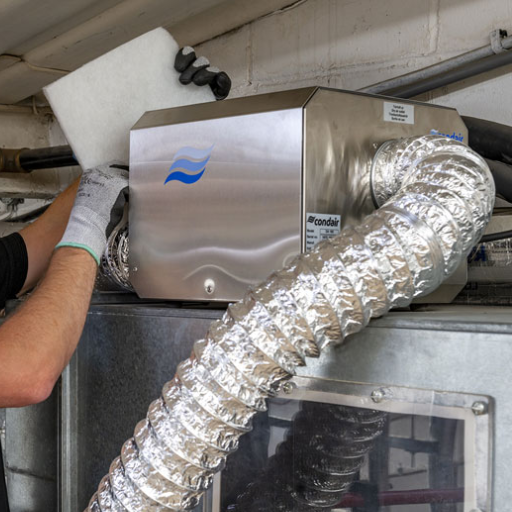
You may encounter several issues when installing a dehumidifier duct, including improper width, leakages, and insufficient airflow. To mitigate these issues, duct width should be made according to the air dehumidifier’s dimensions; this will ensure that airflow isn’t restricted or inefficiency is minimized. Permanently seal the joints with mastic or foil tape to eliminate leaks that affect the device’s working. Dampers should be adequately used to manage airflow and avoid overheating. Also, regular maintenance like duct inspection and filter cleaning can maintain optimal performance and fix issues on time. Following these practices ensures that the device works efficiently to the required performance.
How do we address potential air leaks in the ductwork during installation?
To prevent air leakage during ductwork installation, it is critical to first secure all duct joints and seams with duct mastic or UL-listed foil tape, which are guaranteed to provide a leakproof seal. Refrain from utilizing standard duct tape, which breaks down with time and introduces inefficiency in the system. Subsequently, thoroughly inspect all fittings, such as elbows and transitions, for joint misalignment and rectify and streamline any that may be out of place before putting on the seal. Overlapping parts of flexible ducting require sealing & clamping, and adjustable clamps should be used for all joints involving ducting materials. After ductwork, a pressure test should be conducted to help detect any leftover leakage and make it easier to deal with. These methods produce a sealed system with brisk airflow and minimal energy loss.
What should you do if your existing duct system is incompatible with a whole-house dehumidifier?
If a dampness controller designed for the whole house cannot be fitted to duct your system, I suggest conversing with a competent HVAC technician. They can recommend running a separate return duct for the humidifier or retrofitting the existing system to help with integration. A permanently situated dehumidifier attached directly to the ductwork is another alternative. Avoiding a situation where the units overlap is beneficial for performance, ensuring no limitations.
How do you balance dehumidification with your existing air conditioning system?
De-humidifying with air conditioners requires airing and cooling efficiently while not causing strain to either system. The air conditioner should be set at a setting that does not overshoot and cause discomfort to the user but ensures that the air is heavy once cooling is done. If the moisture levels drastically reduce with the air conditioner, then a more suitable option would be to install a dehumidifier. The area where the HVAC system operates should have a placed humidifier that sets the humidistat to the desired levels, between 30% – 50%. The filters must be cleaned and inspected regularly for both systems to work effectively. Building insulation and sealing any duct leakage can aid in the seamless operation of the de-humidifier and air conditioning without putting excess strain on the system.
How do you maintain and optimize your ducted dehumidifier for maximum efficiency?

To maintain the heating and cooling systems, air filters are changed or cleaned periodically as dirty filters can obstruct the airflow, lowering its working efficiency. I tend to clean the coils every couple of months to allow better moisture removal and prevent dust accumulation. It is also essential to check the condensate drain line to prevent blockages that will result in leakage. The ductwork is adequately sealed and insulated to eliminate air leakages and thus achieve efficiency. The humidistat is also periodically calibrated to maintain an ideal, desired humidity range of thirty to fifty percent, which helps the system function properly. Lastly, annual professional maintenance is booked to ensure the proper cleaning and performance testing and that the issues are identified and addressed on time.
What regular maintenance tasks are required for a whole-house dehumidifier?
The seamless operation of a whole-house dehumidifier, as well as the average cost of its repairs, can be easily mitigated through routine maintenance. When airflow channels are concerned, such errands include cleaning or replacing filters every period between one and three months. During such investigations, as it is suggested that a dehumidifier is also cleaned in the spring, the evaporator and condenser coils should be cleaned to enhance the heat exchange. To avoid mold development from water accumulation, checking the condensate drain line for clogs is necessary. Ducts should be inspected for possible damage or leaks and adequately insulated and sealed. Also, a humidistat should be tested regularly to ensure it works accurately, and if not, it must be recalibrated. Together with the other tasks mentioned and the annual professional servicing, these tasks allow the unit to maximize its benefits and effectiveness in regulating humidity within the premises while prolonging its lifespan.
How do you adjust humidity levels for optimal comfort and energy savings?
My humidistat settings are limited to 30-50% to obtain sufficient comfort while efficiently conserving energy. During colder months, condensation on windows could be a problem; this is why lower settings are preferred, while higher settings are used during warmer months to ensure high comfort levels. To combat moisture from the outside, I ensure my house is tightly sealed and use a dehumidifier, which requires clean filters to function optimally. The goal is to increase energy conservation and maintain the dew point of my house, which is why I also use professional servicing alongside my filter replacements to ensure everything works in synergy.
When should you consult an HVAC contractor for dehumidifier servicing?
Suppose there are any signs of unusual odors from the dehumidifier or a strange amount of noise. In that case, the servicing should be handled by an HVAC contractor, as these are key indicators that something is off with the unit. If the HVAC cannot maintain a specific humidity level or there are tasks such as turning it on and off too often or leaking it, these too could require servicing. Regular maintenance is recommended to ensure there is no heat-related problem that can lead to further system malfunctions. Sometimes, it’s important not to repair the mechanical or electrical faults due to the risk of the warranty being voided or the unit facing further issues. At this point, professionals should easily be able to assist.
What are the potential drawbacks of incorporating a dehumidifier into your ducting?
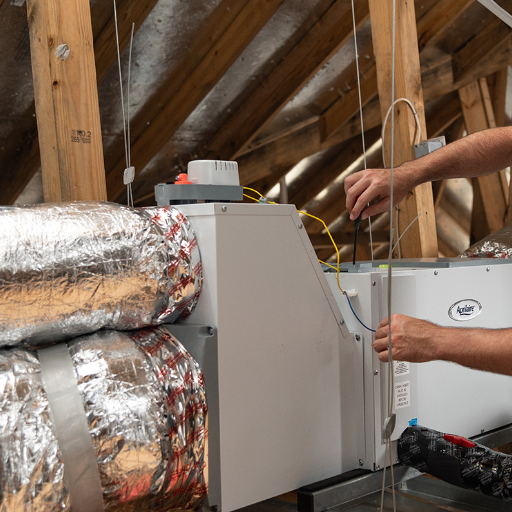
Many challenges come with installing a dehumidifier in the ducting system. To start, the installation is usually quite complicated; it involves changing the HVAC system, which can be expensive. Poor installation of these can also make it harder to ventilate, decreasing cost efficiency. A centralized dehumidifier uses more energy than a portable one, so the energy bills may also increase. Furthermore, ducted dehumidifiers are more challenging to maintain than other dehumidifiers, and Some require regular servicing and cleaning. Last but not least, if the system is not calibrated or sized correctly, it will be unable to keep humidity at desired levels, leading to the entire house not working correctly.
How might a whole-house dehumidifier impact your energy consumption?
Due to its larger operational area and power consumption than portable dehumidifiers, fixing a dehumidifying system for your home may require much more energy. It should be noted that while this helps retain appropriate humidity levels so as not to overwork your HVAC, the energy saved does not appear to negate the costs related to the device itself entirely. The daily power consumption of dehumidifiers varies considerably based on their size, efficiency, and duration of use, with estimates ranging from 4.2 to 10.5 KWH. Energy-efficient variable-speed systems can tone down some of the running expenses associated with fans on these models. However, this figure will likely increase if the unit is too big for the space it’s being used in, incorrectly fitted, or used when it’s not needed. Regular servicing, dedication to necessary upgrades, and prioritization of energy-efficient models should lower electricity expenses.
Are there any noise concerns with ducted dehumidifiers?
Dehumidifiers with ductwork can make some noise, although they are usually quieter than portable models. The noise level depends on the unit’s location, the ductwork design, and the fan’s speed. Correctly positioned units placed in quieter locations and using sound-proofed ducts have a healthier range of noise suppression. Furthermore, some new models are more peaceful and include variable-speed fans, which can help lower the overall noise even more.
What are the long-term costs associated with maintaining a whole-house dehumidification system?
The dehumidification system for an entire house involves extensive expenditure such as energy consumption, professional servicing, and the need for routine maintenance or part replacements. On the other hand, the energy cost is difficult to estimate due to the factors that need to be considered, like the location humidity, system efficiency, and frequency of use. Professional servicing and routine maintenance of the dehumidification system are critical to ensure optimal performance and a prolonged lifespan, which requires removing dust and debris from the ductwork and coils, cleaning or replacing air filters, and inspecting the condensate pump. Gradually, other components, such as fans, compressors, and drainage systems, will also need replacement. Still, the system requires regular servicing, which is supposed to be done every year or every other year, but this only helps decrease the system’s running costs in the long run while at a price.
References
Frequently Asked Questions (FAQ)
Q: What is a whole house dehumidifier, and how does it work?
A: A whole-house dehumidifier is designed to remove moisture from the air throughout your home. It works by pulling humid air from your living spaces, removing the moisture, and circulating dry air into your home. This process helps maintain optimal humidity levels, improving air quality and comfort.
Q: How do I choose the right location to install a whole-house dehumidifier?
A: The best location for a whole-house dehumidifier is typically near your existing HVAC system, often in the basement or a utility closet. This placement allows easy integration with your current ductwork and ensures efficient air circulation throughout the house. When selecting the installation spot, consider factors such as accessibility for maintenance, drainage options, and noise levels.
Q: Can I connect a whole house dehumidifier to my existing HVAC system?
A: You can connect a whole-house dehumidifier to your HVAC system. The dehumidifier can be integrated with your air handler or heat pump, allowing it to work with your heating and cooling system. This integration ensures that dehumidified air is distributed evenly throughout your home using the existing ductwork.
Q: How do I duct a dehumidifier properly?
A: To properly duct a dehumidifier, connect it to both the supply and return sides of your HVAC system. The dehumidifier pulls air from the return side of the air handler, dehumidifies it, and then sends the dry air back into the supply duct. Ensure you use leak-free and appropriately sized duct systems to maintain optimal airflow and efficiency.
Q: What are the benefits of using a ventilating dehumidifier?
A: A ventilating dehumidifier combines dehumidification with ventilation, offering several benefits. It helps remove moisture from the air while introducing fresh outdoor air into your home. This dual functionality improves indoor air quality, reduces humidity levels, and helps meet ventilation requirements. It’s beneficial in tightly sealed, energy-efficient homes that may lack natural ventilation.
Q: How do I ensure proper airflow when installing a whole-house dehumidifier?
A: To ensure proper airflow, consider using a dedicated return for the dehumidifier instead of tying it into the primary return. This approach prevents the dehumidifier from competing with the air handler’s blower. Additionally, ensure the dehumidifier’s supply air is connected to the supply side of your HVAC system, allowing for even distribution of dehumidified air throughout your home.
Q: Can a whole-house dehumidifier help with cooling my home?
A: While a whole-house dehumidifier’s primary function is to remove moisture from the air, it can indirectly help with cooling. Reducing humidity levels makes your home feel calmer and more comfortable. This can allow you to set your air conditioner to a slightly higher temperature, potentially saving energy. However, a dehumidifier is not a replacement for an air conditioner in terms of actual cooling.
Q: How often should I run my whole house dehumidifier?
A: The frequency of running your whole-house dehumidifier depends on various factors, including your local climate, home insulation, and personal comfort preferences. You may need to run it more frequently during humid seasons or naturally damp areas like basements. Many whole-house dehumidifiers have built-in humidistats that automatically maintain your desired humidity level, running only when needed.



